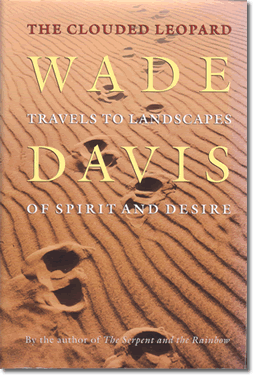The Art of Living
 “The greatest of all the arts is life itself.”—
“The greatest of all the arts is life itself.”—
Dr. James T. Shotwell (1874-1965), renowned historian, international statesman and longtime resident of Woodstock
♦ ♦ ♦ ♦ ♦ ♦ ♦ ♦ ♦ ♦ ♦
An Interview with Wade Davis
Wade Davis was a guest on WoodstockArts’ The Book Report in 1999. Mr. Davis was inspired and trained to be an ethnobotanist at Harvard University by Richard Evans Schultes. (The latter discovered the sacred mushrooms of the Aztec-known as the flesh of the gods-in the 1930’s and became the father of the psychedelic era.) Mr. Davis spent over three years in the Amazon and Andes, living among 15 indigenous groups in eight Latin American nations while making 6,000 plant collections for the Harvard Botanical Museum. He is author of such international bestsellers as The Serpent and the Rainbow (1986), Penan: Voice for the Borneo Rain Forest (1990) and One River (1996). He is also a board member of the David Suzuki Foundation and Ecotrust, and is Explorer in Residence at the National Geographic.
 The following is an excerpt from a 60-minute radio interview on his book, The Clouded Leopard, taped on March 22, 1999 with program host, Weston Blelock.
The following is an excerpt from a 60-minute radio interview on his book, The Clouded Leopard, taped on March 22, 1999 with program host, Weston Blelock.
WB: “It is fascinating to me that the indigenous people of the Amazon would simply be able to walk around and engage in their normal activities and that in the course of that the plants seemed to have an affinity for them and would sing to them.”
WD: “There are many mysteries we have not begun to address scientifically. One of those is just how the indigenous people find their medicinal plants. I mean the first example of that is the sacred shamanic preparation ayahuasca, the vision vine. Now this is a liana or a vine in the moonseed family. This liana has inside of it a series of beta-carbolines, which are mildly psychoactive or hallucinogenic. But there’s another set of preparations used in the Amazon that are based on alkaloids called tryptamines. Now tryptamines are orally inactive.
You can drink or eat as much of these as you want and nothing will happen, because they are denatured in the human gut by an enzyme that occurs there called monoamine oxidase. Now what’s curious is that those tryptamines are powerfully psychoactive. They can be taken orally, taken in the presence of some other substance that inhibits that enzyme in the human gut. It turns out that the beta-carbolines inside the liana ayahuasca are inhibitors of the precise sort necessary to potentate the tryptamines that are found in these other plants.
What does this mean? It means in a forest of 80,000 species the shamans have found the two morphologically unrelated plants. One’s a vine, one’s a shrub…that when combined create a powerful synergistic effect. In biochemical terms, the whole being is greater than the sum of the parts. And that is the main preparation of the shaman’s repertoire.
Now how on earth did they find that? Well, the standard scientific explanation of trial and error falls apart and is exposed as a kind of euphemism. But if you ask the Indian people themselves, they will tell you that the plants sing to them differently. In another instance there is a tribe who live in the upper reaches of the Amazon in Columbia where 17 varieties of a certain vine are found. Now as a western trained botanist I would say that all of those varieties were the same species. But the indigenous people recognize the 17 as being distinct and they recognize them consistently across time and space and through different regions of the forest.
And you ask them, ‘How do you tell?’ And they say, ‘I thought you said you were botanists. Don’t you know anything? Well you take these plants on the night of the full moon and each of them sings to us in a different key.’ And this, of course, wouldn’t get you a PhD. in Dalhousie, but it would give you a sense that maybe there are worlds beyond our world. Our world does not exist in an absolute sense. When you realize there are other models of reality, other ways of being, other ways of thinking and other whole fountains of knowledge that have come about in the history of the earth, you recognize that maybe these indigenous people know things that we simply don’t know. That’s been my experience and I try to reflect upon that in The Clouded Leopard.”
Weston Blelock notes, “In the intervening years this particular segment of the interview has stayed with me. One spring recently while mowing the lawn, I came abreast of a swath of dandelions. I was startled when they seemed to address me by saying it would be a pity to mow them since they could make a valuable contribution to my health. I stopped in my tracks. Three days later I was consulting a herbal handbook and I found that dandelion tea is a specific remedy for a condition I had. Needless to say I have been enjoying the benefits of dandelion tea ever since.”
We welcome your comments or “Living Artfully” anecdotes.
Please submit them by clicking here; be sure to write “Living Artfully” in the subject line.
